 At about 8:30 in the morning, the train stops among fields of straggly wheat. There is a distant road, telegraph poles and lots of prickly pear cactus. It's raining. After about fifteen minutes, the rain eases and stops; passengers begin to get out to wander up and down along the track beside the train. No-one, including the train crew, is absolutely sure what's wrong. Half an hour into the stop, a small band of angry businees-types decide to head across fields to the road, where occasional cars and lorries were passing. The ticket collector tries to reason with them, but they shout him down and march off. It begins to rain again, heavily now. We all clamber up the high steps back into the train and chat. A hyper-active yoga teacher from Camden, is travelling to Marrakech to find his space, and then on to the ocean to be cleansed. He's lived in Barcelona and Paris; likes living in London, but the energy gets to him, and every now and then he has to escape. Surprisingly, one of the travellers is a character we last saw sitting on the Terrace of the Cafe Tingis in Tangier. He looks like Oscar Wilde, or Augustus Carp, depending on your point of view (he's in the photo, immediately behind and to the left of the gentleman in the djellaba). He speaks Spanish very rapidly and he's swapping information about where you can get to from Casablanca with Nick and another passenger. It seems that you can fly cheaply to Zaire from there, if I understood him right. Eventually things start to happen. The train crew take the wooden chocks from behind the wheels and we see a locomotive speeding towards us from the direction of Marrakech. In a few minutes there's a jolt, and we begin to move ... slowly. There's mild pandemonium at the station. The train is an hour and a half late and there's nowhere for taxis to wait that long, so as the passengers crowd out of the station, they're pounced on by frazzled taxi-drivers. We hang back, not because we're wise, but because I decide that I have to have a pee before I can go anywhere! By the time we leave the station, the rush is over and get a petit taxi to take us to the Djema al-Fna, the central square in the old city. We haven't booked an hotel, but when the talkative driver asks us about this, and if we know anywhere, Faith jumps in quickly with, "We've made a reservation at Hotel Ali."! This blatant untruth, delivered with alarming sincerity, gets a nod and the reply, "Ahhh. Yes, everyone knows Ali's." And so we're dropped outside the hotel after having all the location of all the main 'must sees' pointed out by the driver. He's horrified that we're here for only a day and a half and warns us that we'll have to come back.Why Hotel Ali? No other reason than that it cropped up in the guide books as popular with backpackers, and Faith remembered the name. It looks promising, though. The dark hotel hallway opens onto the street where people are drinking soft drinks or tea, and there's a busy, open plan reception desk inside. It's surrounded by travellers, staff, locals exchanging handsful of Euros for Dirhams, piles of rucsacks and cases and the pedestrians who are using the lobby as a short-cut to the parallel street behing the hotel. There is room for us. Aziz, who seems to be the manager and maitre d'hotel, looks through his ledger book and a pile of keys, and eventually gives us Room 116.
At about 8:30 in the morning, the train stops among fields of straggly wheat. There is a distant road, telegraph poles and lots of prickly pear cactus. It's raining. After about fifteen minutes, the rain eases and stops; passengers begin to get out to wander up and down along the track beside the train. No-one, including the train crew, is absolutely sure what's wrong. Half an hour into the stop, a small band of angry businees-types decide to head across fields to the road, where occasional cars and lorries were passing. The ticket collector tries to reason with them, but they shout him down and march off. It begins to rain again, heavily now. We all clamber up the high steps back into the train and chat. A hyper-active yoga teacher from Camden, is travelling to Marrakech to find his space, and then on to the ocean to be cleansed. He's lived in Barcelona and Paris; likes living in London, but the energy gets to him, and every now and then he has to escape. Surprisingly, one of the travellers is a character we last saw sitting on the Terrace of the Cafe Tingis in Tangier. He looks like Oscar Wilde, or Augustus Carp, depending on your point of view (he's in the photo, immediately behind and to the left of the gentleman in the djellaba). He speaks Spanish very rapidly and he's swapping information about where you can get to from Casablanca with Nick and another passenger. It seems that you can fly cheaply to Zaire from there, if I understood him right. Eventually things start to happen. The train crew take the wooden chocks from behind the wheels and we see a locomotive speeding towards us from the direction of Marrakech. In a few minutes there's a jolt, and we begin to move ... slowly. There's mild pandemonium at the station. The train is an hour and a half late and there's nowhere for taxis to wait that long, so as the passengers crowd out of the station, they're pounced on by frazzled taxi-drivers. We hang back, not because we're wise, but because I decide that I have to have a pee before I can go anywhere! By the time we leave the station, the rush is over and get a petit taxi to take us to the Djema al-Fna, the central square in the old city. We haven't booked an hotel, but when the talkative driver asks us about this, and if we know anywhere, Faith jumps in quickly with, "We've made a reservation at Hotel Ali."! This blatant untruth, delivered with alarming sincerity, gets a nod and the reply, "Ahhh. Yes, everyone knows Ali's." And so we're dropped outside the hotel after having all the location of all the main 'must sees' pointed out by the driver. He's horrified that we're here for only a day and a half and warns us that we'll have to come back.Why Hotel Ali? No other reason than that it cropped up in the guide books as popular with backpackers, and Faith remembered the name. It looks promising, though. The dark hotel hallway opens onto the street where people are drinking soft drinks or tea, and there's a busy, open plan reception desk inside. It's surrounded by travellers, staff, locals exchanging handsful of Euros for Dirhams, piles of rucsacks and cases and the pedestrians who are using the lobby as a short-cut to the parallel street behing the hotel. There is room for us. Aziz, who seems to be the manager and maitre d'hotel, looks through his ledger book and a pile of keys, and eventually gives us Room 116. 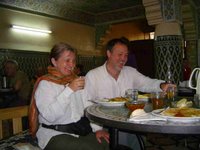 It's a triple, but he'll charge us the demi-pension rate of 170dH each (that's about 34 Euros in total for dinner, bed and breakfast, with use of the hammam thrown in). We don't argue. Once again it's a typical Moorish building. There are outside open spaces - terraces - and inside open spaces - cushioned communal eating and sitting areas. The whole thing is built around a central open quadrangle and goes up three floor to two further roof terraces where visitors can eat and, in the summer, sleep in the open air. Nobody'll be doing that today. There's water everywhere. It's still raining, and last night's storm obviously took people by surprise. Outdoor furniture is piled in covered corners under plastic sheets (does this mean that it's no longer outdoor furniture?), the cleaning women are busy mopping up puddles and there are basins and buckets all around, catching the water that's found its way from the outside to the inside of the hotel. In our room there are three single beds, a bathroom and toilet (WITH PAPER!), and that smell that causes parents to ask, "When did you last clean the rabbit's hutch?". Faith isn't concerned, but I am; I don't want to find any nasty surprises in dark
It's a triple, but he'll charge us the demi-pension rate of 170dH each (that's about 34 Euros in total for dinner, bed and breakfast, with use of the hammam thrown in). We don't argue. Once again it's a typical Moorish building. There are outside open spaces - terraces - and inside open spaces - cushioned communal eating and sitting areas. The whole thing is built around a central open quadrangle and goes up three floor to two further roof terraces where visitors can eat and, in the summer, sleep in the open air. Nobody'll be doing that today. There's water everywhere. It's still raining, and last night's storm obviously took people by surprise. Outdoor furniture is piled in covered corners under plastic sheets (does this mean that it's no longer outdoor furniture?), the cleaning women are busy mopping up puddles and there are basins and buckets all around, catching the water that's found its way from the outside to the inside of the hotel. In our room there are three single beds, a bathroom and toilet (WITH PAPER!), and that smell that causes parents to ask, "When did you last clean the rabbit's hutch?". Faith isn't concerned, but I am; I don't want to find any nasty surprises in darkcorners. The smell is stronger when I open the window and the door to try to blow it through, and I soon find out why.
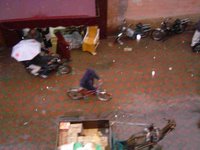 Two floors below us a miserably wet donkey, hitched to a flatbed cart, is steaming under a sheet of plastic.An umbrella is our only significant purchase in Marrakech! We buy it from the umbrella-dude (as seen in Lisbon, among other places) who appears from nowhere once the rain begins to fall. We bargain him down to 20dH from 30dH but he looks very happy, so he's certainly made a good profit on us. With the help of the umbrella, we avoid further umbrella-dudes and explore the twisty warren of streets and squares around the medina. A visit to a merchant's house, now a a museum, gives us an insight into the ubiquitous use of wood in Moroccan construction, and we see an interesting collection of "woollen tools", that is, tools for making wool, and not crocheted scewdrivers and the like. The rain continues to fall and it becomes hazardous avoiding speeding, wet donkey carts in the medina! Sheltering under stall awnings and communicating mutual surprise is a good way to get smiles from the locals. As evening falls, the traders begin to set up in the Djema al-Fna, though they're thin on the ground. There are snake charmers, a few musicians and lots of stands selling cooked food - tagine, brochettes, sausages, sheeps' heads, brains and snails. Unfortunately, we've already eaten a huge and delicious help-yourself-Moroccan-supper at Ali's, but we try some spiced tea and cake. It's very good. The tea contains cardamom, nutmeg and masses of ginger. The cake is very sweet, but delicious with the tea. There are a lot of locals drinking at the stall and there's constant patter bewteen the owner and his customers. A tourist couple, just finishing their tea as we arrive are teased with, "The virtue of the tea is that now you will be able to satisfy three wives!". The wife looks shocked; the man looks worried. There's lot of giggling among the other customers. We have two cups each, and sleep like babies.On our second day, the sun is shining and it's hot. We leave our luggage at Ali's and set off for the square ...
Two floors below us a miserably wet donkey, hitched to a flatbed cart, is steaming under a sheet of plastic.An umbrella is our only significant purchase in Marrakech! We buy it from the umbrella-dude (as seen in Lisbon, among other places) who appears from nowhere once the rain begins to fall. We bargain him down to 20dH from 30dH but he looks very happy, so he's certainly made a good profit on us. With the help of the umbrella, we avoid further umbrella-dudes and explore the twisty warren of streets and squares around the medina. A visit to a merchant's house, now a a museum, gives us an insight into the ubiquitous use of wood in Moroccan construction, and we see an interesting collection of "woollen tools", that is, tools for making wool, and not crocheted scewdrivers and the like. The rain continues to fall and it becomes hazardous avoiding speeding, wet donkey carts in the medina! Sheltering under stall awnings and communicating mutual surprise is a good way to get smiles from the locals. As evening falls, the traders begin to set up in the Djema al-Fna, though they're thin on the ground. There are snake charmers, a few musicians and lots of stands selling cooked food - tagine, brochettes, sausages, sheeps' heads, brains and snails. Unfortunately, we've already eaten a huge and delicious help-yourself-Moroccan-supper at Ali's, but we try some spiced tea and cake. It's very good. The tea contains cardamom, nutmeg and masses of ginger. The cake is very sweet, but delicious with the tea. There are a lot of locals drinking at the stall and there's constant patter bewteen the owner and his customers. A tourist couple, just finishing their tea as we arrive are teased with, "The virtue of the tea is that now you will be able to satisfy three wives!". The wife looks shocked; the man looks worried. There's lot of giggling among the other customers. We have two cups each, and sleep like babies.On our second day, the sun is shining and it's hot. We leave our luggage at Ali's and set off for the square ... 
The Sting: I am taking a general photograph of the square, artfully including a group of snake charmers in the middle distance for effect. In a moment, Faith has a snake draped around her neck and we are being drawn into their midst. There's drumming, more snakes, "Arab luck!" You bet. One of the group smiles widely, takes the camera and photographs us, all be-serpented, and a growing group of onlookers watches appreciatively. The camera's returned with more smiles. Now we must pay. It's no good saying no - we've already taken part and have the photos in the camera. There's a crowd, too, and who wants to look as stupid and mean as they feel? So, we bargain the price down from 200dH to nearer 100dH, and we're allowed to go. A measure of their happiness with the deal is that we're allowed to take some more pictures for free and wished huge amounts of Arab luck. Ignominy! It was an uncomfortable and unexpected experience, but it teaches that, where photos are concerned, it is sometimes necessary to buy a small piece of someone's soul rather than to attempt to take it by stealth. We have two maps. They quickly help us to get lost. There are no road signs in the souks, they've all been taken down or painted out. This way, you have to stop to look at your map and this gives little boys the chance to offer to guide you, or men the opportunity to suggest that you'd do well to follow them to the very special display of Berber goods that, fortunately for you, is held today only! As in Tangier, women don't get involved in this business, though often there are women begging charity. All this aside, the whole thing is stupendously fascinating. We've seen these narrow streets in cities like Cordoba, Malaga and Avila, which used to have Moorish communities, but there, they're sanitised and regulated. Marrakech brings them to life. Here, in streets just wide enough for laden donkeys to pass, where you can't see the sky because of the high walls and the reed-mat awnings, trade is taking place at a hectic pace all around, woven into the life of the people living in the medina. In some parts of the souk, much of what's being sold is for tourists, of course, but wool and leather dyeing are still happening, and you find the skeins and skins hung or laid to dry in the sun; there are precarious piles of fresh vegetables, a stinking live-poultry souk and men carrying sacks of fresh flatbread. An old man, sitting on a box and holding out a bowl with a few coins inside, has his grey djellaba raised above his waist to show his grossly deformed and swollen stomach, like a huge pink cauliflower, over his trousers; children are coming home from school; cats prowl for scraps and kittens run for their lives from Mobilettes; a group of locals berates and pushes-about a man whose thin and mangy donkey, pulling a cart piled with wooden pallets, has ground to a halt, blocking their square.
 Three buildings stand out in our wanderings today: the Madrasa ben Youssef, because it demonstrates that student life in 16th century Marrakech would have been recognisable to students studying in Oxford or Cambridge colleges at the same time - even down to lodging-rooms arranged in staircases and opening onto a quadrangle; the 12th century Quobba al-ba'Adiyn, because it's the protoype for almost all of the Arab-Andalucie architecture that we've seen repeated time and again throughout Spain; and the Koutoubia mosque that dominates the Djema al-Fna, whose towering minaret has sisters in Rabat and Seville, and in whose shady, evening rose gardens locals court discreetly, one couple to a bench.It's almost time for us to collect our luggage and make our way back to the station, but we pay a last visit to the square as the sun sets behing the mosque. The western sky is the colour of brass and the air above the square is smoky and loud with the sound of drumming, bells shawms and fiddles. The food stalls have begun to do brisk business.
Three buildings stand out in our wanderings today: the Madrasa ben Youssef, because it demonstrates that student life in 16th century Marrakech would have been recognisable to students studying in Oxford or Cambridge colleges at the same time - even down to lodging-rooms arranged in staircases and opening onto a quadrangle; the 12th century Quobba al-ba'Adiyn, because it's the protoype for almost all of the Arab-Andalucie architecture that we've seen repeated time and again throughout Spain; and the Koutoubia mosque that dominates the Djema al-Fna, whose towering minaret has sisters in Rabat and Seville, and in whose shady, evening rose gardens locals court discreetly, one couple to a bench.It's almost time for us to collect our luggage and make our way back to the station, but we pay a last visit to the square as the sun sets behing the mosque. The western sky is the colour of brass and the air above the square is smoky and loud with the sound of drumming, bells shawms and fiddles. The food stalls have begun to do brisk business.  Last night there was room to walk about between groups of people in the damp evening. Not tonight. Every inch is filling up. there are musicians, acrobats, stotytellers, card sharps, fortune tellers, snake charmers, dancing "girls", women who henna hands, a fishing-for-bottles man, men with apes, sweet sellers, tea sellers, water-men, dancers, jewellery sellers, soothsayers, beggars and many, many cats. We look and wonder a bit more, buy some fresh orange juice and a big bag of dates and make our way back to Hotel Ali, the train to Tangier and, tomorrow morning, the fast boat to Algeciras.
Last night there was room to walk about between groups of people in the damp evening. Not tonight. Every inch is filling up. there are musicians, acrobats, stotytellers, card sharps, fortune tellers, snake charmers, dancing "girls", women who henna hands, a fishing-for-bottles man, men with apes, sweet sellers, tea sellers, water-men, dancers, jewellery sellers, soothsayers, beggars and many, many cats. We look and wonder a bit more, buy some fresh orange juice and a big bag of dates and make our way back to Hotel Ali, the train to Tangier and, tomorrow morning, the fast boat to Algeciras.



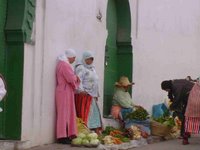





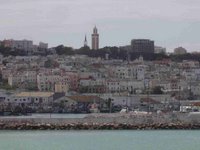 Tangier!
Tangier! 
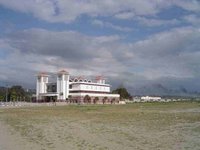





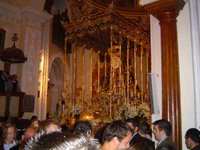




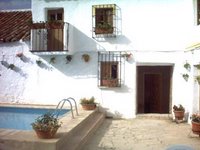


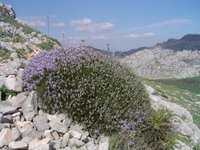



 Nothing, nothing, I assure you, but I've just been re-reading the Voyage of the Beagle and it reminds me that when Charles Darwin wasn't chasing finches and fossicking on dry land, he was only able mumble
Nothing, nothing, I assure you, but I've just been re-reading the Voyage of the Beagle and it reminds me that when Charles Darwin wasn't chasing finches and fossicking on dry land, he was only able mumble